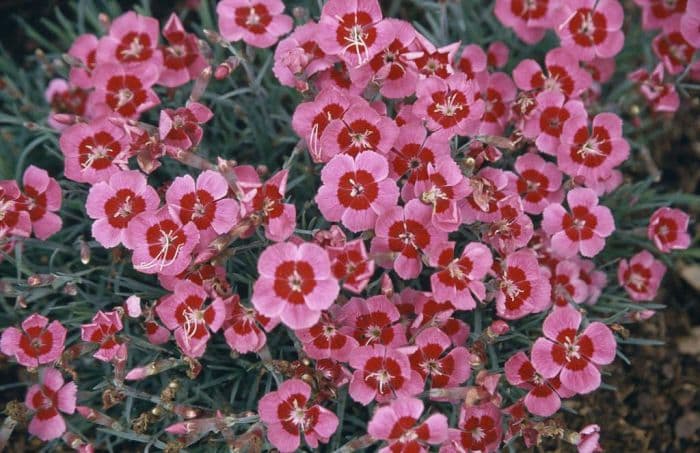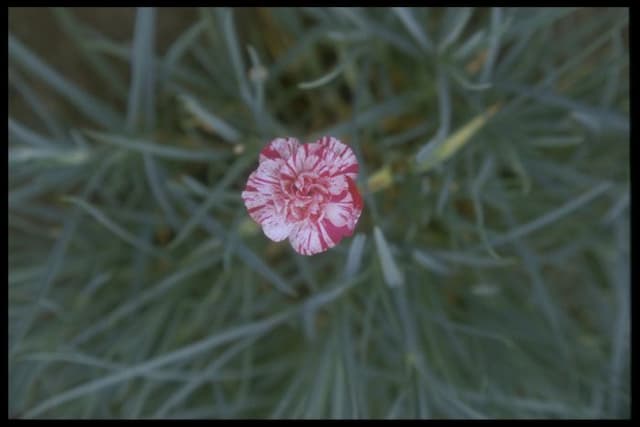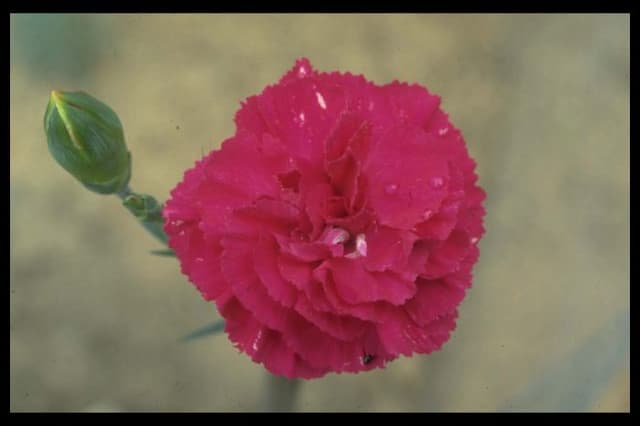Carnation Dianthus 'Betty Morton' (p)

ABOUT
Dianthus 'Betty Morton' is a strikingly beautiful plant known for its showy flowers and lush foliage. The blooms of this plant are particularly eye-catching, with frilly petals that create a fluffy, textured appearance. The flowers are often a charming pink hue, sometimes with darker or lighter variations that can include stripes or edged patterns, exuding a classic yet vibrant look. These blossoms are typically carried high above the foliage on sturdy, slender stems, making them highly visible and excellent for cut-flower arrangements. The leaves of Dianthus 'Betty Morton' contribute to its attractive appearance as well. They are narrow, with a blue-green or grayish-green color that contrasts elegantly against the bright flowers. They are typically quite long and may have a grass-like appearance, which forms a dense tuft or clump. This foliage not only provides a lush background for the flowers but also remains visually appealing even when the plant is not in bloom. Overall, Dianthus 'Betty Morton' has a neat and tidy appearance, with a well-rounded shape and a plush, full look due to the closely packed foliage and abundant flowering. Its refined petals and vibrant colors make it a delightful addition to any garden space, container, or as an edge alongside a walkway, where its beauty can be fully appreciated up close.
About this plant
 Names
NamesFamily
Caryophyllaceae
Synonyms
Sweet William, Pinks
Common names
Dianthus 'Betty Morton'
 Toxicity
ToxicityTo humans
The common name for Dianthus 'Betty Morton' is carnation. Carnations are not considered highly toxic to humans. However, if ingested in large quantities, they may cause mild gastrointestinal upset, including nausea, vomiting, or diarrhea. It's important to note that individual sensitivity to plants can vary, so some people might experience a stronger reaction than others.
To pets
Carnations are considered to be mildly toxic to pets. If a pet ingests carnations, they may exhibit symptoms such as gastrointestinal upset including vomiting and diarrhea. In more sensitive individuals, dermatitis can also occur from contact with the plant. While the toxicity is generally low, it is still best to prevent pets from ingesting the plant to avoid any potential discomfort.
 Characteristics
CharacteristicsLife cycle
Perennials
Foliage type
Evergreen
Color of leaves
Blue-green
Flower color
Pink
Height
1 foot (0.3 meters)
Spread
1 foot (0.3 meters)
Plant type
Herb
Hardiness zones
5
Native area
Europe
Benefits
 General Benefits
General Benefits- Enhances Garden Aesthetics: Adds vibrant colors and unique textures to garden settings.
- Attracts Pollinators: Draws in bees and butterflies, supporting the local ecosystem.
- Aromatic Flowers: The blooms emit a pleasant fragrance which can enhance the sensory experience of a garden.
- Long Blooming Season: Provides a long period of visual interest throughout its blooming cycle.
- Drought Tolerance: Once established, it can tolerate periods of dryness, reducing the need for frequent watering.
- Low Maintenance: Requires minimal care beyond initial establishment, making it suitable for novice gardeners.
- Cold Hardy: Resistant to cold temperatures, making it suitable for a range of climates.
 Medical Properties
Medical PropertiesThis plant is not used for medical purposes.
 Air-purifying Qualities
Air-purifying QualitiesThis plant is not specifically known for air purifying qualities.
 Other Uses
Other Uses- Carnation 'Betty Morton' can act as a natural dye for fabrics and textiles, offering shades of pink to purple depending on the mordant used.
- Their fragrant petals can be used to infuse sugars and syrups, adding a floral note to desserts and drinks.
- Carnation petals can be incorporated into homemade potpourri mixtures for a pleasant aroma in the home.
- They are sometimes used in crafting, particularly in paper making, to add color and texture to handmade paper.
- Pressed Carnation flowers can be used in decorative arts such as resin jewelry, where their beauty is preserved in necklaces or earrings.
- The flowers can be used to add a colorful garnish to salads and cold dishes for an edible decorative touch.
- When dried, Carnation petals can be used as a natural confetti at celebrations, being both biodegradable and colorful.
- Carnation blooms are used in the creation of floral waters and natural perfumes due to their intense and sweet fragrance.
- Used in bath products, Carnation petals can adorn bath bombs and salts for a luxurious bathing experience.
- Carnation flowers can serve as a natural pH indicator in science education, changing color in the presence of basic substances.
Interesting Facts
 Feng Shui
Feng ShuiThe Carnation is not used in Feng Shui practice.
 Zodiac Sign Compitability
Zodiac Sign CompitabilityThe Carnation is not used in astrology practice.
 Plant Symbolism
Plant Symbolism- Love: Dianthus is often associated with love due to its historical use in gardens and bouquets, often given to express romantic interest and affection.
- Admiration: The bright and varied colors of the Dianthus, including the 'Betty Morton' cultivar, can signify admiration and fascination, making it a perfect gift to show someone your high regard for them.
- Boldness: Dianthus flowers have a striking appearance and a spicy fragrance that can symbolize boldness or even a daring spirit, reflective of taking bold steps in life or relationships.
- Divine Favor: In historical contexts, the Dianthus was sometimes associated with the divine, with the name 'dianthus' itself meaning 'flower of the gods,' thus symbolizing the idea of divine favor or blessings.
- Purity: The flowers, especially in lighter shades like those of 'Betty Morton,' can also represent purity and innocence, echoing the flower's clean lines and simple form.
 Water
WaterThe Carnation 'Betty Morton' should be watered thoroughly, allowing the top inch of soil to dry out between waterings. Ideally, this may equate to watering once every week, but this can vary depending on climate and soil conditions. When watering, it's best to avoid wetting the foliage to reduce the risk of fungal diseases. Depending on the size of the plant and the environmental conditions, water with approximately one to two gallons at a time to ensure the root zone is moistened.
 Light
LightCarnation 'Betty Morton' thrives best in full sun conditions where it can receive at least six hours of direct sunlight daily. Position the plant in a location that is bright and receives unfiltered sunlight for the majority of the day. Avoid shaded areas as insufficient light can impact the plant's blooming and overall health.
 Temperature
TemperatureCarnations prefer temperate conditions and can perform well in temperatures that range between 60 and 70 degrees Fahrenheit. They are capable of surviving short periods of colder weather down to 40 degrees Fahrenheit and can tolerate highs up to 80 degrees Fahrenheit. However, maintaining an ideal temperature within the preferred range will ensure the best growth and flowering.
 Pruning
PruningPruning Carnations like 'Betty Morton' is essential to promote bushy growth and abundant blooms. Deadhead spent flowers regularly to encourage more blooms, and trim back the plant after flowering has ceased, usually in late summer or early fall. Also, remove any dead or yellowing foliage to maintain a neat appearance and reduce disease risk. The best time for heavy pruning is in early spring, just before new growth begins.
 Cleaning
CleaningAs needed
 Soil
SoilThe best soil mix for 'Carnations' like Dianthus 'Betty Morton' is well-draining with a pH between 6.0 and 7.5. A mixture of loam, sand, and organic matter such as compost or peat will create an ideal environment for healthy growth. Regular fertilization during the growing season will keep the flowers vibrant.
 Repotting
RepottingCarnations do not need frequent repotting and can be done every 2 to 3 years. It is best to repot when the plant becomes root-bound or the soil appears depleted of nutrients. Spring or late summer is the optimal time to repot these plants.
 Humidity & Misting
Humidity & MistingCarnations prefer an environment with relatively low humidity. They thrive in average home humidity levels but should be placed in a well-ventilated area to prevent issues with excessive moisture and ensure proper air circulation.
 Suitable locations
Suitable locationsIndoor
Place in bright light, away from direct heat, in well-draining soil.
Outdoor
Full sun location, well-drained soil, space 12 inches apart.
Hardiness zone
3-9 USDA
 Life cycle
Life cycleDianthus 'Betty Morton'—commonly known as Carnation or Pinks—begins its life cycle as a seed, which upon germination in suitable conditions, develops into a young seedling. As the seedling grows, it forms a sturdy root system and foliage through the vegetative stage, and when mature, it produces stems with tight clusters of leaves. Following the vegetative stage, Carnations enter the flowering stage, typically in late spring to early summer, where they produce attractive, fragrant flowers in shades of pink. After pollination, which can occur through the assistance of insects or wind, the flowers develop into capsules containing seeds. Once the seeds mature, they are dispersed by various mechanisms, falling to the ground to begin a new cycle or collected for cultivation. Finally, Carnations may enter a period of dormancy during colder months, conserving energy before resuming growth in the next season.
 Propogation
PropogationPropogation time
Spring-Early Summer
The Dianthus 'Betty Morton', commonly referred to as Carnation, is most successfully propagated in the late spring to early summer using stem cuttings. To propagate Carnations by stem cuttings, a gardener should select a healthy, non-flowering stem and cut a 4 to 6-inch (approximately 10 to 15 cm) portion below a leaf node. This cutting should then have its lower leaves removed and the base dipped in a rooting hormone to accelerate root development. It is then placed in a mixture of half perlite and half peat, ensuring high humidity and consistent moisture without waterlogging. The cuttings typically root within a few weeks, after which they can be transplanted to their permanent location.









